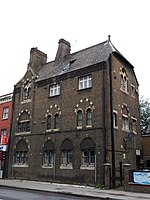Lambeth

Lambeth () is a district in South London, England, in the London Borough of Lambeth, historically in the County of Surrey. It is situated 1 mile (1.6 km) south of Charing Cross. The population of the London Borough of Lambeth was 303,086 in 2011. The area experienced some slight growth in the medieval period as part of the manor of Lambeth Palace. By the Victorian era the area had seen significant development as London expanded, with dense industrial, commercial and residential buildings located adjacent to one another. The changes brought by World War II altered much of the fabric of Lambeth. Subsequent development in the late 20th and early 21st centuries has seen an increase in the number of high-rise buildings. The area is home to the International Maritime Organization.
Excerpt from the Wikipedia article Lambeth (License: CC BY-SA 3.0, Authors, Images).Lambeth
Jonathan Street, London Vauxhall (London Borough of Lambeth)
Geographical coordinates (GPS) Address Nearby Places Show on map
Geographical coordinates (GPS)
| Latitude | Longitude |
|---|---|
| N 51.49 ° | E -0.119 ° |
Address
New Economics Foundation
Jonathan Street 3
SE11 5NH London, Vauxhall (London Borough of Lambeth)
England, United Kingdom
Open on Google Maps








